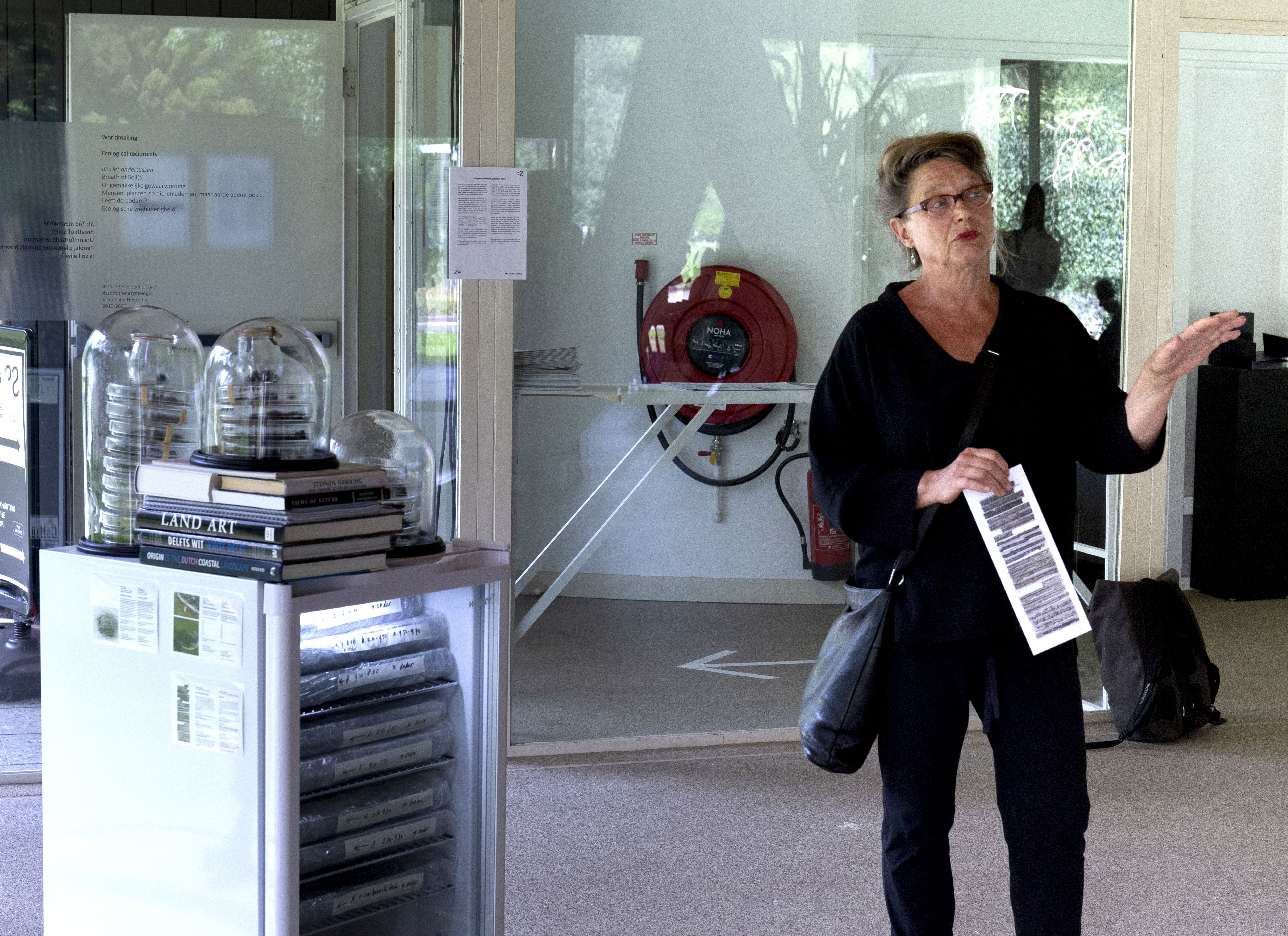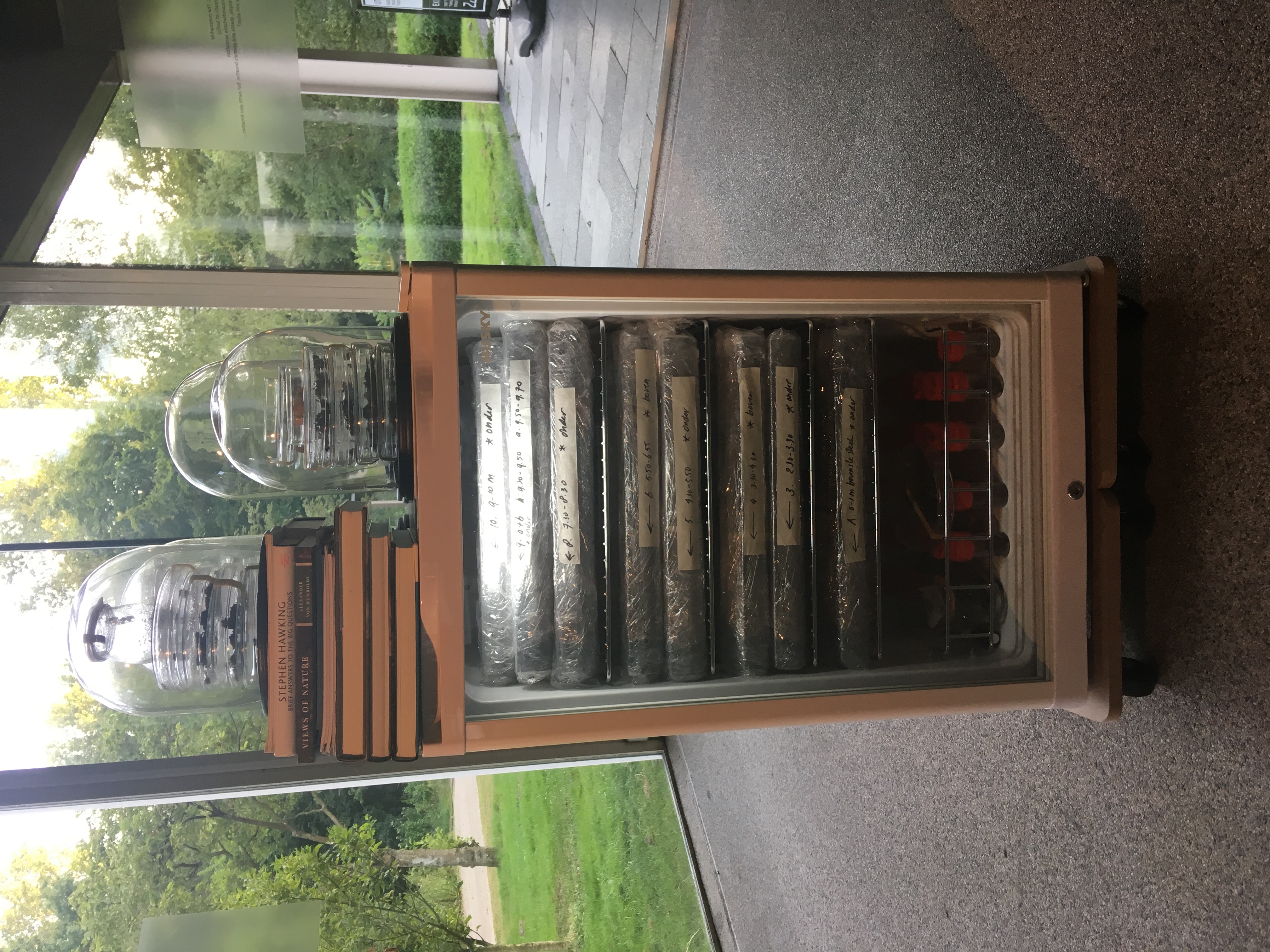Jacqueline Heerema
The work op Jaqueline Heerema is part of Explode View, read more
Breath of Soil(s), Jacqueline Heerema
Artist Jacqueline Heerema explores the phenomenon of ‘time’ and the representation of nature-culture and climate in the subsurface landscape. As a result, she brings to light a layered storytelling landscape and shows the soil as a living climate archive. Jacqueline started spring 2019 with a reconstruction of the genesis of ‘Land in wording’ (no.18 in the Amstelpark), drilled during the public intervention ‘Onland’ (September 2019) with experts in the bottom of this swamp to a depth of 10 meters and a time depth of approx. 6000 years and appropriated these soil materials. During this soil drilling, Heerema was confronted with a rather uncomfortable sensation, which she calls ‘Breath of Soil(s)’. People, plants and animals breathe, but earth also breathes…. Is soil alive? With her installation in Glazen Huis Jacqueline focuses our attention on the vulnerability of the earth and our ecological reciprocal relationship with soil. She offers an encounter with living soil.
With special thanks to Stroom Den Haag, Bert van der Valk (geologist, Deltares), Tanya Lippmann (climate scientist, VU).
Read on for more background information about her artistic research in Amstelpark in the context of the Exploded View research project.
The time of the earth is not (yet) in our system.
Faced with current and future environmental challenges, we need to develop a new view of the planet and of the self. With a practice in the arts and cultural heritage I tend to perceive the world from a cultural perspective, with a focus on the history of humanity and human-induced processes. Working with a wide range of artists, designers and scientists, I learn to include the non-human narrative, the pre-human history of nature. This helps me to provoke new ideas about the origins of both nature and culture, to enhance a deeper understanding of their interconnectivity, of the time-depht of landscapes, earth and atmosphere, and of ourselves as human agency.
Refugium – A climate landscape as a living archive
Or: The Truman Show?
How can we experience time? Or better said: how can we experience the time-depth of a landscape? Can we not only explore the landscape horizontally, but also vertically? Is the experience of the current ‘Anthropocene’ or the Age of Humanity based on doom scenarios or do we, people, also create future opportunities? What does a cultural or natural landscape mean and to what extent does humanity stand above or next to or in the middle of nature if the landscape is a park? Who feels emotional ownership of this park? Does a park have a future besides a past? These and other questions shape the park research, while being led by curiosity about the opportunities that climate variations can offer us in the context of the phenomenon of a park.
The confusion of nature and culture
An exercise in anticipation, of embodiment of time
Being able to actually touch time sparks the imagination. Jacqueline Heerema develops an artistic program about time, as an exercise in anticipation, of embodiment of time.
We all have some notion of time and lifespan. But with the current discourses about deep time, deep earth, deep sky etc., we may get lost. The future is unforeseen. The so-called sixth extinction is the first that the human species experience, instigated by our own actions. There is no previous scenario we can relate to, no referential guideline to follow. We are still in the process of trying to figure out what to do.
However, we can target at understanding the near foreseen future. By embracing change, combining nature-induced and human-induced historical processes into a mapping of the near foreseen future that we can percieve, Heerema targets at different ways of seeing and being and explores three timescales: The becoming, The being and The meanwhile.
The becoming relates to the reference points of time and space in the becoming of what is now.
The being relates to our perceptions of the present and the self in this process.
The meanwhile targets at further appropriations for the future.
The becoming
At the intersection of palaeontology, geology and archaeology, the place we perceive now as Land in wording at Amstelpark has a long subsurface history. Going back in time, the sediments deposited by wind, water (sea and rivers) and ice (glaciers) and more recently human-induced layers (dikes, polders, sand subsidence for the making of Buitenveldert, soil deposits for the making of Amstelpark, peat for the making of Land in Wording), we get a vertical impression of the now, the notion of transitional processes and the relational self.
Drilling in the soil to collect a sediment core can be seen as a method to get a grip on time, of living, once living and non-living ecosystems, including disruptions of time and place. Reference collections of sediments, minerals, species, fossils and artifacts help to construct narratives around the concept of time. And to reconstruct previous assumptions into new narratives and timely insights.
The being
The focus is Land in Wording, freely translated as Land to Be or Land in the Becoming, number 18 at the map of Amstelpark. According to the website of Amstelpark, this is the only area in the park that is said to be untouched by humans, with so-called pre-Floriade conditions. The context of Land in Wording is the pond, and across the pond the area that stretches from the Japanese Garden (no. 30) to Hop (no. 17).
The meanwhile
The current timeframe is one of ethics of appropriations. We slowly start to realize the impact of human interventions and the resulting confusion of time and place. Following the nature-induced processes into the making of the (sub)surface, humanity disperses enormous quantities of raw materials, species and gasses around the planet and beyond. For the cultivated horticultural show Floriade 1972 and current Amstelpark, everything comes from somewhere else and was/is subject to timely interpretations of shifting values of nature that is not natural.
Jacqueline Heerema (NL, 1958) is conceptual artist, studied museology, works as independent urban curator, is experienced in engaged large scale new heritage projects and develops interactive community based collections to develop new artistic insights that she connects to non-artistic domains. She transformed an urban neighbourhood into ‘Museum Oostwijk’, de-constructed the classic concept of museums in ‘The Chamber of Marvels’, and is founding director and curator of Satellietgroep since 2006.
Heerema invented the new concept of Innovatory Heritage, in which heritage itself is subject to change form static/exclusive into dynamic/inclusive. Most of all, she collects, connects and interconnects local knowledge on a global level and acts as a catalyst between society, arts and science.
More information at lxwxdxtime.world/timeline/




